Curiosity at the bottom
Finally, NASA shared the results of the Curiosity study for December and half of January. And for the purpose of drilling it was also determined. The main news summary: almost all the minerals that now surround the rover, formed with the participation of water. That is, in fact, it is located at the bottom of the former ancient Martian reservoir.

Only two meters drove Curiosity from the moment he tested his brush in action. Since then, over the week, he has sent so many things that amaze, surprise, or baffle that it is time to say “do not cook the pot.” But he continues right now, and this is Mars, so go on with the potty.
First things first.
About a month ago, Curiosity entered a new type of surface of Mars, which was characterized by high thermal inertia. This means that it heats up more slowly and cools more slowly, which indicates a high rock density. (Read more about the geology of the crater Gale habrahabr.ru/post/162567 )

(The lilac area is with high thermal inertia. The cross is the landing site, the red points are the route of movement .)
Then the landscapes changed, and under the wheels of the rover went powerful stone slabs, covered with wide cracks:

')
Even then, for similarities with the reservoir, the place was called Yellowknifle Bay (Yellowknife Bay, after a town in Canada).
Analysis of the airborne climate station REMS showed that the temperature indicators of the soil really changed:
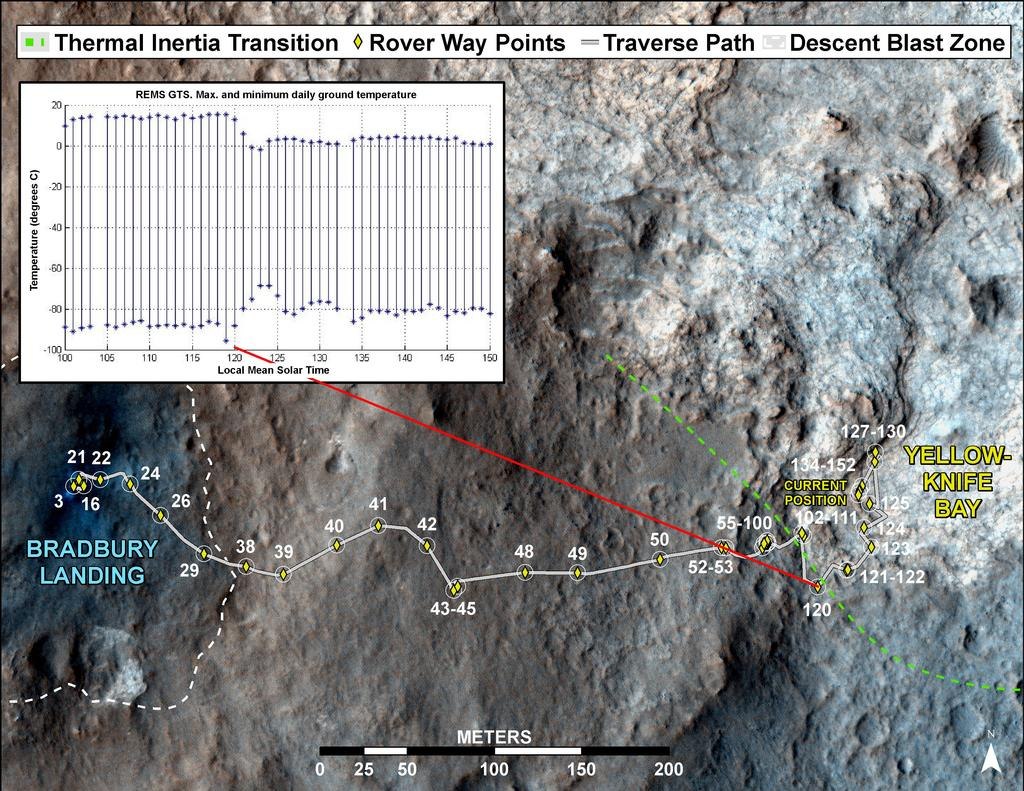
The result is particularly marked by 120 sol, when the rover approached the third type of Glenelg surface, which will be studied later. The site, named Shaler, attracted attention with its unusual layered structure:
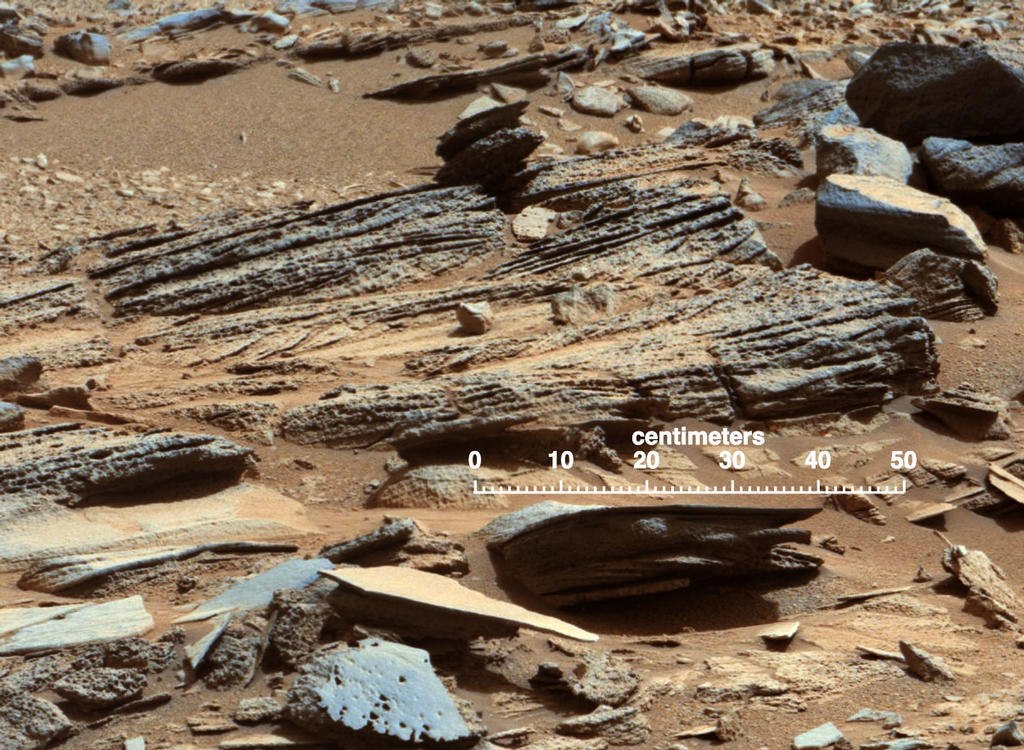
According to NASA geologists, it is also formed by water, but unlike Yellowknifle Bay, water flow worked here, not a standing water body.
The lower flat part, the “bottom” of the bay, is surrounded by a low threshold, which differs in its material from the bottom part:

Curiosity proceeded to the study of "gender" and "threshold":

Immediately, characteristic white veins were seen that penetrated almost all the cracks in the valley. White arrows are marked with veins, black ones are small mineral nodules. Geologists know similar veins on Earth, but the Martian were thoroughly analyzed:
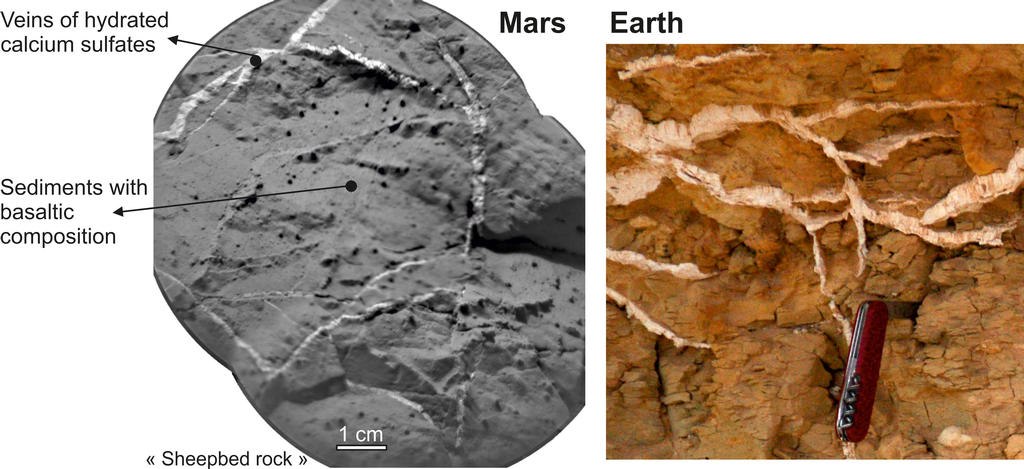
The result was quite expected - it is hydrated calcium sulfate, most likely in the mineral form of gypsum. Calcium sulfate is found in Yellowknifle Bay in two forms: veins and "nodules". The veins are formed in moderate temperatures, when water that is saturated with sulfur and calcium circulates through cracks between the stones. That is definitely in a certain period of time there was liquid water here, and so long that she managed to hammer in all the cracks with plaster.
In addition to gypsum veins, there are also gypsum “nodules”:

NASA shared with the public the results of spectral analysis of a single core (Crest) and “nodules” (Rapitan):
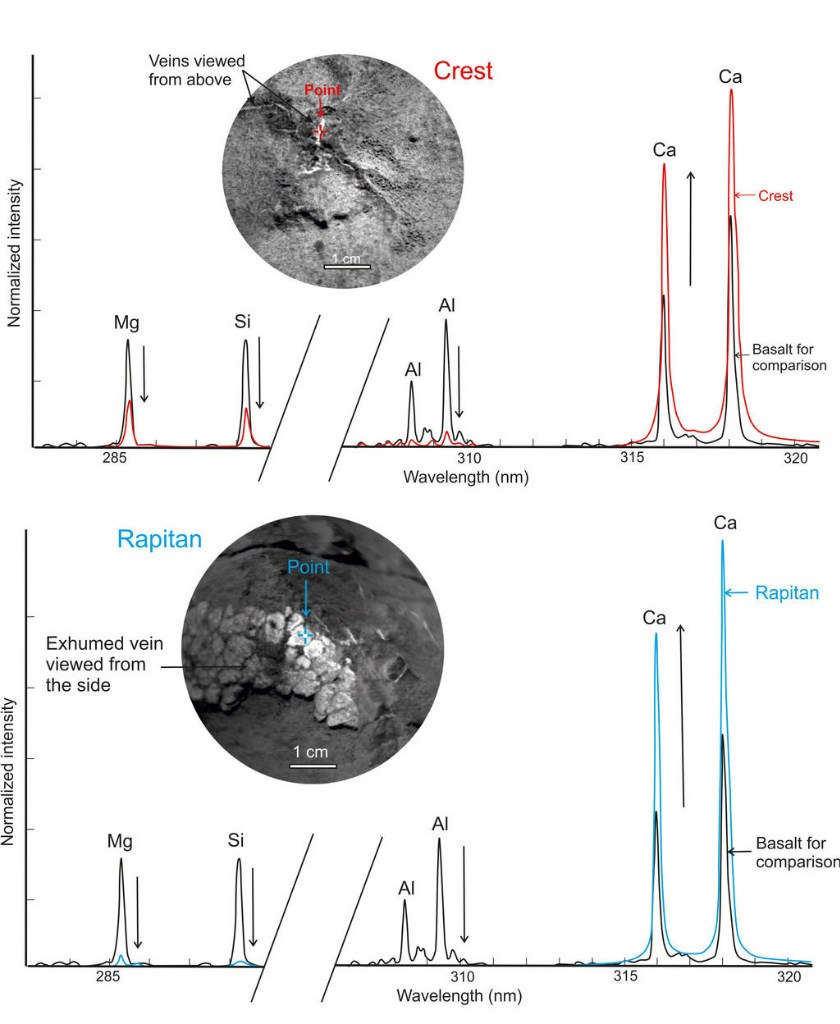
Since gypsum is a mineral that binds water, an increase in the concentration of hydrogen in the soil should be observed. That is, the results of the DAN instrument readings should change in an interesting direction. They have not yet been made public, but hydrogen is also determined using ChemCam:
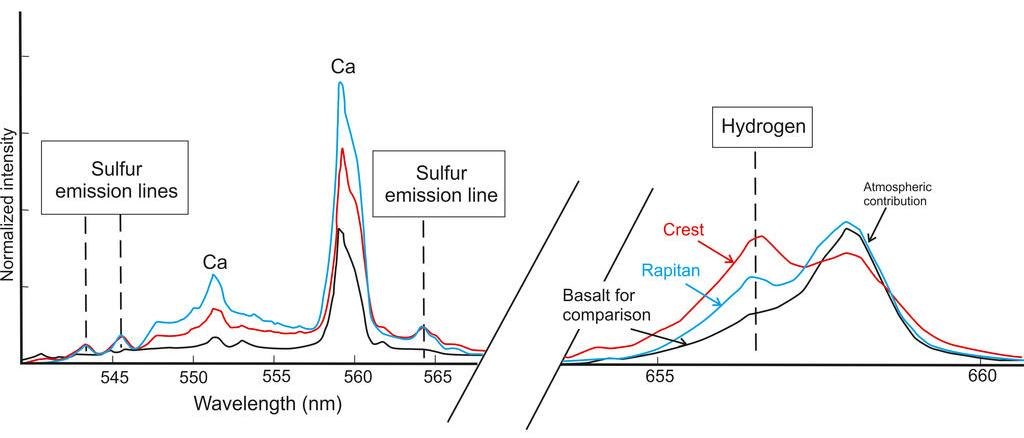
In the bottom part there were balls. In general, the balls on Mars are not a deficit. Opporutnity found two types of balls completely different in structure, material and origin. Now Curiosity has begun to replenish its collection:

According to geologists, NASA are mineral nodules that form in the bottom layer of a reservoir. Below are already indigenous basaltic rocks, which, probably, still remember the asteroid that gave rise to the crater of Gale.
Stone "threshold" is also formed with the participation of water, but in completely different conditions. It is cemented sandstone mixed with larger granules of various minerals. One of these 2 mm granules, most likely quartz, was nicknamed “the Martian flower” by journalists. (More about this story here: habrahabr.ru/post/164759 ).

Curiosity had already approached the “threshold” several times, but it was only now that it took a serious study:

In general, he chose a surprisingly rich place to explore. "Threshold" was not easy. As seen in the general photos, it is cut by a longitudinal crack:

Just yesterday, the rover looked into it and showed that it is not simple, but with a “filling”:
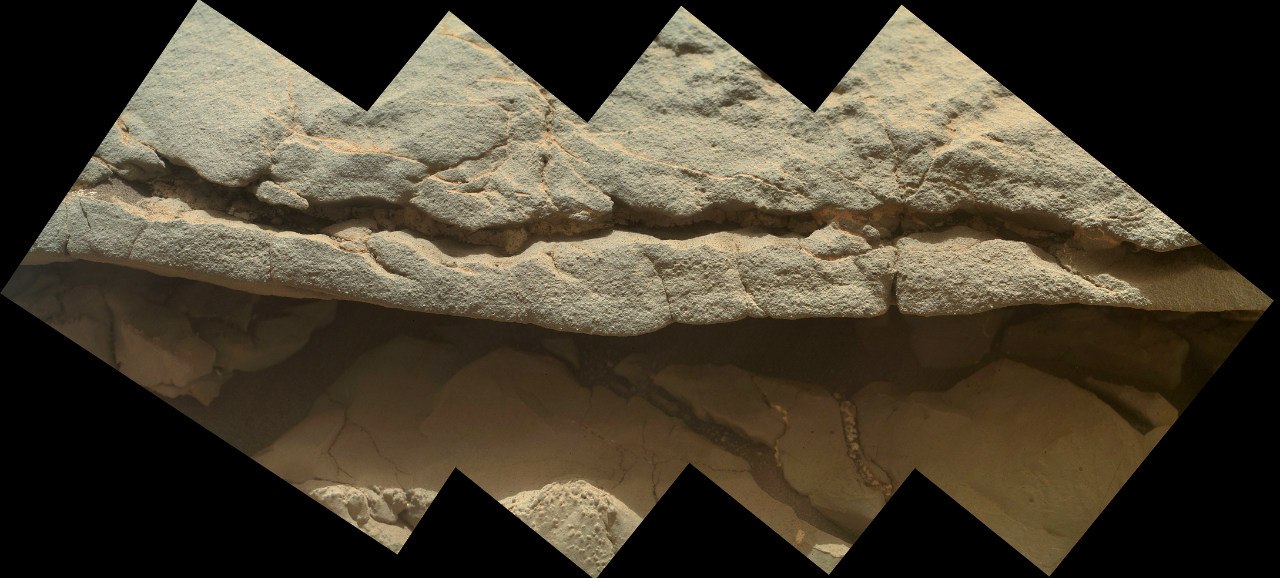
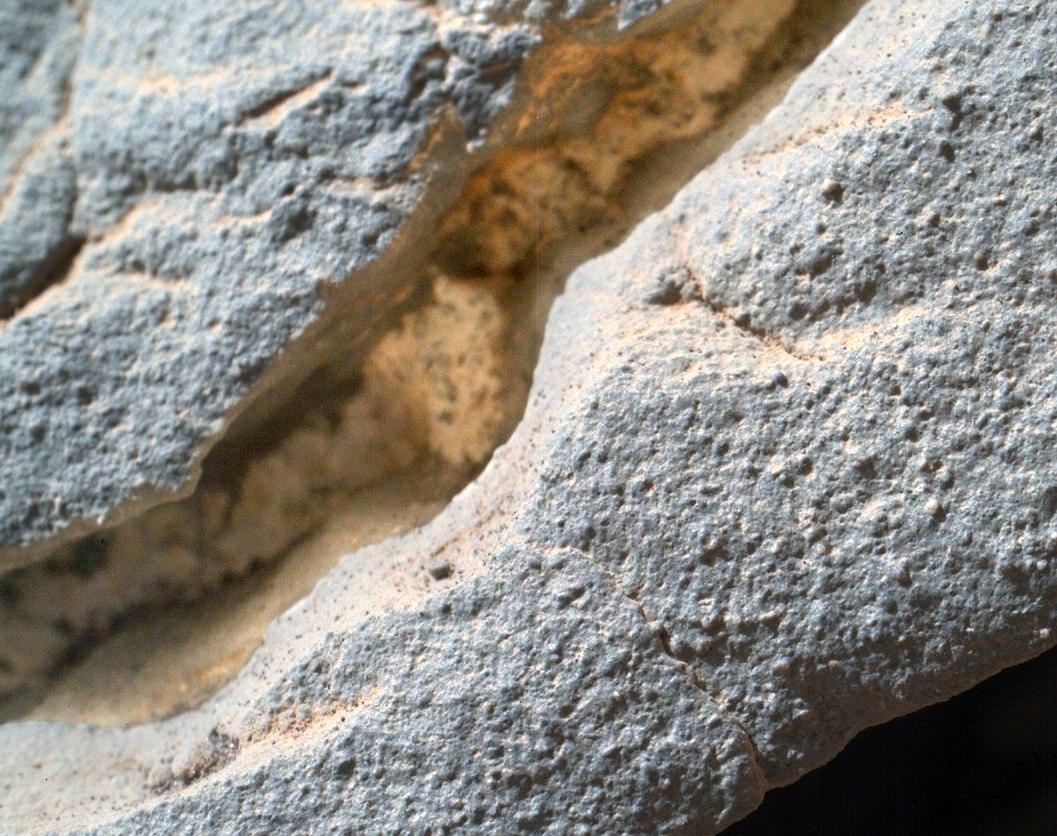
However, the most interesting was found even earlier:
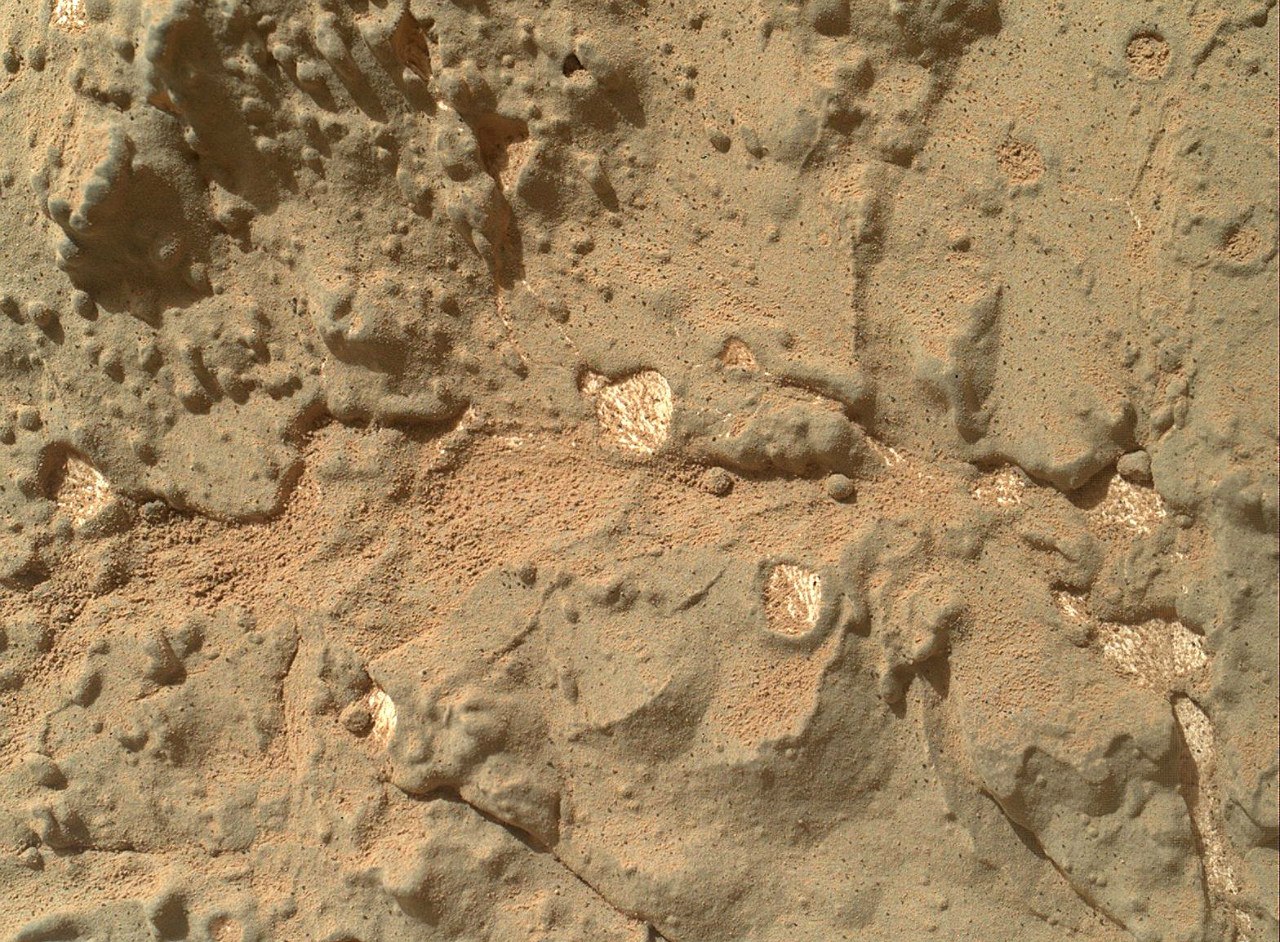
This is the most natural petrified dirt on Mars. The scale (the wide side of the image is about 7-10 cm) suggests that nothing but small mineral particles with water could form such leaks. NASA describes this breed as “siltstone” - “petrified silt”, although the term “ aleurite ” is used in geology.
The day before yesterday, when NASA had not yet told about the results of the research, the news "Curiosity found fossilized dirt on Mars" was worthy of the front pages of yellow newspapers, but even it dimmed when the next batch of pictures came:
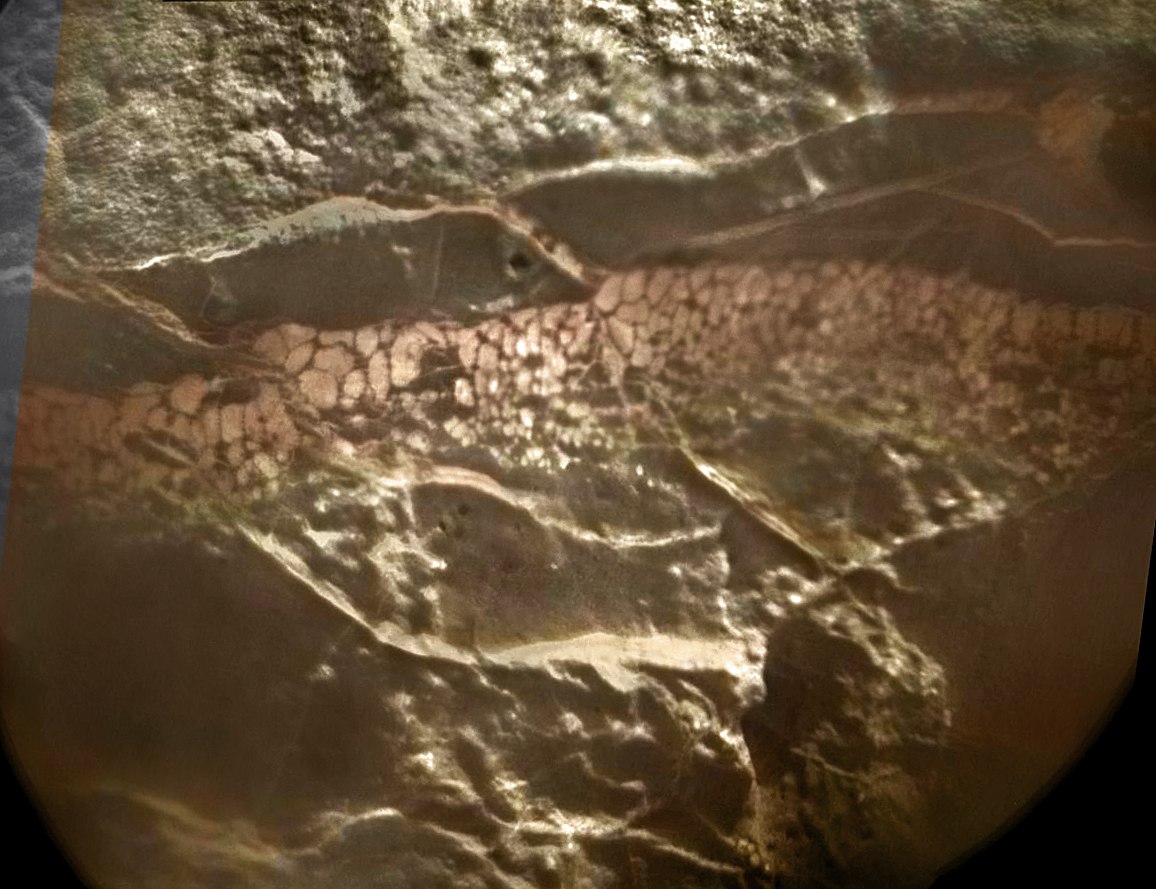
This is a mosaic of photos of ChemCam, which reveals a texture resembling foam . In the photograph of the mast chambers this layer is not so expressive:

Well, it consists, as we now know, of plaster "knots", so it is unlikely that NASA will pay more attention to it than it can do remotely. Although questionable is the process of its formation. According to one version, these were gypsum granules, which were flooded with the same “dirt”; according to another, it was a porous type of pumice, in which gypsum accumulated in the same way as in cracks.
Now, finally, about where Curiosity will be drilled.
The place called "John Klein" is at the bottom. I thought they would choose sandstone for safety reasons, but they preferred a more promising place from a scientific point of view.

It looks like a dry puddle, where the dirt cracked on the plates and reared up. They identified three sites to which we would like to draw our attention. Square "A" identifies "veins as ridges" - the type of cracks, characteristic only for this geological layer. “B” indicates the layered nature of the surface, that is, a 5 cm drill can go through several thin layers, which is more interesting for research. Section "C" is highlighted to draw attention to a crack that is not filled with anything and may be a larger fracture in the depth that goes outside.
More plot can be viewed on the panorama in GigaPan .
Now a small conclusion. Yes, there was water on Mars, there were a lot of it, and these are not sporadic short-term spills caused by meteorites or volcanoes. The streams formed pebbles, accumulated "silt" and precipitated solutes at the bottom. But in these facts there is no novelty. Opportunity found the same, except, perhaps, only pebbles. And gypsum and other minerals formed by water are in his piggy bank. The fact is that all these are traces of water that flowed on Mars in the period of the Hesperides. When on the planet raging powerful volcanic eruptions, and their emissions filled the atmosphere and water with sulfur and chlorine compounds. But it is still not clear what played the most fatal role for the Martian possible life. Either sulfuric acid and perchlorates, or eruptions themselves. It is well known that two recent Great extinctions on Earth 250 million and 65 million years ago are associated with two powerful eruptions in Siberia and India . So, if life had been there before, she did not survive her doomsday. Therefore, “dirt” and gypsum do not promise signs of life. The most delicious is ahead.
( "Pink" photos are calibrated by NASA. They write "processed as it would have looked on Earth" )
PS Although I understand that nothing of the local fauna can be here, I continue to peer at all the new pictures in the hope of seeing that pessimistic realism was wrong. I write the results here, on Habr, on Twitter and VKontakte .

Only two meters drove Curiosity from the moment he tested his brush in action. Since then, over the week, he has sent so many things that amaze, surprise, or baffle that it is time to say “do not cook the pot.” But he continues right now, and this is Mars, so go on with the potty.
First things first.
About a month ago, Curiosity entered a new type of surface of Mars, which was characterized by high thermal inertia. This means that it heats up more slowly and cools more slowly, which indicates a high rock density. (Read more about the geology of the crater Gale habrahabr.ru/post/162567 )

(The lilac area is with high thermal inertia. The cross is the landing site, the red points are the route of movement .)
Then the landscapes changed, and under the wheels of the rover went powerful stone slabs, covered with wide cracks:

')
Even then, for similarities with the reservoir, the place was called Yellowknifle Bay (Yellowknife Bay, after a town in Canada).
Analysis of the airborne climate station REMS showed that the temperature indicators of the soil really changed:

The result is particularly marked by 120 sol, when the rover approached the third type of Glenelg surface, which will be studied later. The site, named Shaler, attracted attention with its unusual layered structure:

According to NASA geologists, it is also formed by water, but unlike Yellowknifle Bay, water flow worked here, not a standing water body.
The lower flat part, the “bottom” of the bay, is surrounded by a low threshold, which differs in its material from the bottom part:

Curiosity proceeded to the study of "gender" and "threshold":

Immediately, characteristic white veins were seen that penetrated almost all the cracks in the valley. White arrows are marked with veins, black ones are small mineral nodules. Geologists know similar veins on Earth, but the Martian were thoroughly analyzed:

The result was quite expected - it is hydrated calcium sulfate, most likely in the mineral form of gypsum. Calcium sulfate is found in Yellowknifle Bay in two forms: veins and "nodules". The veins are formed in moderate temperatures, when water that is saturated with sulfur and calcium circulates through cracks between the stones. That is definitely in a certain period of time there was liquid water here, and so long that she managed to hammer in all the cracks with plaster.
In addition to gypsum veins, there are also gypsum “nodules”:

NASA shared with the public the results of spectral analysis of a single core (Crest) and “nodules” (Rapitan):

Since gypsum is a mineral that binds water, an increase in the concentration of hydrogen in the soil should be observed. That is, the results of the DAN instrument readings should change in an interesting direction. They have not yet been made public, but hydrogen is also determined using ChemCam:

In the bottom part there were balls. In general, the balls on Mars are not a deficit. Opporutnity found two types of balls completely different in structure, material and origin. Now Curiosity has begun to replenish its collection:

According to geologists, NASA are mineral nodules that form in the bottom layer of a reservoir. Below are already indigenous basaltic rocks, which, probably, still remember the asteroid that gave rise to the crater of Gale.
Stone "threshold" is also formed with the participation of water, but in completely different conditions. It is cemented sandstone mixed with larger granules of various minerals. One of these 2 mm granules, most likely quartz, was nicknamed “the Martian flower” by journalists. (More about this story here: habrahabr.ru/post/164759 ).

Curiosity had already approached the “threshold” several times, but it was only now that it took a serious study:
In general, he chose a surprisingly rich place to explore. "Threshold" was not easy. As seen in the general photos, it is cut by a longitudinal crack:

Just yesterday, the rover looked into it and showed that it is not simple, but with a “filling”:


However, the most interesting was found even earlier:

This is the most natural petrified dirt on Mars. The scale (the wide side of the image is about 7-10 cm) suggests that nothing but small mineral particles with water could form such leaks. NASA describes this breed as “siltstone” - “petrified silt”, although the term “ aleurite ” is used in geology.
The day before yesterday, when NASA had not yet told about the results of the research, the news "Curiosity found fossilized dirt on Mars" was worthy of the front pages of yellow newspapers, but even it dimmed when the next batch of pictures came:

This is a mosaic of photos of ChemCam, which reveals a texture resembling foam . In the photograph of the mast chambers this layer is not so expressive:

Well, it consists, as we now know, of plaster "knots", so it is unlikely that NASA will pay more attention to it than it can do remotely. Although questionable is the process of its formation. According to one version, these were gypsum granules, which were flooded with the same “dirt”; according to another, it was a porous type of pumice, in which gypsum accumulated in the same way as in cracks.
Now, finally, about where Curiosity will be drilled.
The place called "John Klein" is at the bottom. I thought they would choose sandstone for safety reasons, but they preferred a more promising place from a scientific point of view.

It looks like a dry puddle, where the dirt cracked on the plates and reared up. They identified three sites to which we would like to draw our attention. Square "A" identifies "veins as ridges" - the type of cracks, characteristic only for this geological layer. “B” indicates the layered nature of the surface, that is, a 5 cm drill can go through several thin layers, which is more interesting for research. Section "C" is highlighted to draw attention to a crack that is not filled with anything and may be a larger fracture in the depth that goes outside.
More plot can be viewed on the panorama in GigaPan .
Now a small conclusion. Yes, there was water on Mars, there were a lot of it, and these are not sporadic short-term spills caused by meteorites or volcanoes. The streams formed pebbles, accumulated "silt" and precipitated solutes at the bottom. But in these facts there is no novelty. Opportunity found the same, except, perhaps, only pebbles. And gypsum and other minerals formed by water are in his piggy bank. The fact is that all these are traces of water that flowed on Mars in the period of the Hesperides. When on the planet raging powerful volcanic eruptions, and their emissions filled the atmosphere and water with sulfur and chlorine compounds. But it is still not clear what played the most fatal role for the Martian possible life. Either sulfuric acid and perchlorates, or eruptions themselves. It is well known that two recent Great extinctions on Earth 250 million and 65 million years ago are associated with two powerful eruptions in Siberia and India . So, if life had been there before, she did not survive her doomsday. Therefore, “dirt” and gypsum do not promise signs of life. The most delicious is ahead.
( "Pink" photos are calibrated by NASA. They write "processed as it would have looked on Earth" )
PS Although I understand that nothing of the local fauna can be here, I continue to peer at all the new pictures in the hope of seeing that pessimistic realism was wrong. I write the results here, on Habr, on Twitter and VKontakte .
Source: https://habr.com/ru/post/165965/
All Articles